August 26, 2020 feature
Lifting a sessile drop from a superamphiphobic surface using an impacting droplet
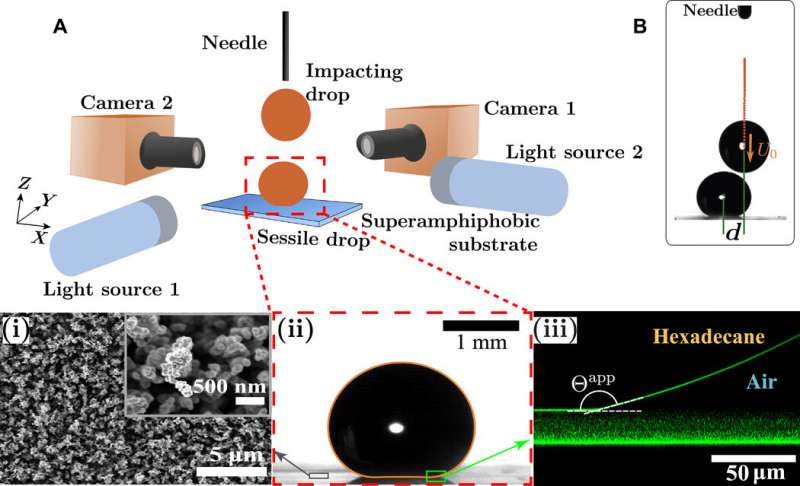
Colliding droplets are ubiquitous in everyday technologies such as combustion engines and sprays, and in natural processes such as raindrops and in cloud formation. The collision outcomes depend on the velocity of impact, degree of alignment, intrinsic properties of surface tension and a low-wetting surface. In a new report on Science Advances, Olinka Ramírez-Soto and a team of scientists in polymer research, fluid dynamics, chemical and materials engineering in Germany, Netherlands and the U.S. investigated the dynamics of an oil drop impacting an identical sessile droplet on a superamphiphobic surface. A superamphiphobic surface is analogous to superhydrophobicity (water repellence), although it can repel both polar and nonpolar liquids. Using numerical simulations, the team recreated rebound scenarios to quantify the velocity profiles, energy transfer and viscous dissipation in the experimental setup. This work showed the influence of impact velocity on rebound dynamics for oil drop-on-drop collisions on superamphiphobic surfaces.
Investigating drop-on-drop impact
When a liquid droplet impacts a sessile drop of an identical liquid, the intuitive expectation is for both drops to coalesce or combine. This process is common with rain and drops from a leaky faucet, but sometimes a thin layer of air between two drops can enable water drops to perfectly bounce from hydrophilic (water-loving) surfaces instead. In the 1800s, scientist and engineer Osborn Reynolds first recorded and credited the gliding motion of water droplets across a pool to this phenomenon. A vapor layer is similarly responsible for the Leidenfrost effect, where a drop hovers above a superheated surface.
Despite experimental characterization of impact dynamics, methods to quantitatively model the velocity fields and energy transfer are lacking. Studies on drop-on-drop impact on superamphiphobic surfaces are currently hampered by a limited number of techniques to design nonwetting surfaces. It is therefore important to understand what scenarios determine drop-on-drop impact of oil on a superamphiphobic surface and how energy is transferred between the drops. In this study, Ramírez-Soto et al. experimentally and numerically studied the dynamics of a low-surface-tension oil drop impacting a sessile liquid of similar composition resting on superamphiphobic surface. The team showed how the impacting oil droplet could lift the resting droplet off the surface without coalescing.
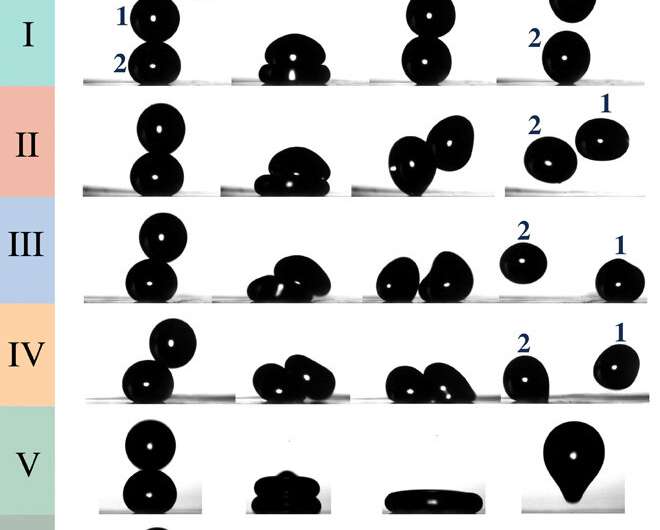
The experimental approach
The scientists conducted four rebound experiments without coalescence. In the first scenario, both drops rebound; in two other scenarios, the impacting drop rebounds while the sessile drop remains, and in the final scenario the sessile drop rebounds while the impacting drop remains surface bound. During the experiments, Ramírez-Soto et al. gently positioned a sessile oil drop on a superamphiphobic surface and impacted it with a second identical drop. They created the superamphiphobic surface using a 20 µm-thick layer of templated candle soot, which contained a porous network of carbon nanobeads. To increase the stability of the fragile network, they deposited a layer of silica on the porous nanostructures. They lowered the surface energy of the soot-templated surface through fluorination to produce a superamphiphobic surface that repelled water and most oils. The scientists used hexadecane as a model oil during the experiments due to a myriad of favorable properties including Newtonian behavior and recorded the angle of a drop of hexadecane using confocal microscopy. The study quantitatively compared the experimental and numerical data of the rebound dynamics. Ramírez-Soto et al. calculated and confirmed the value of the shape of the drop using the Young-Laplace equation.
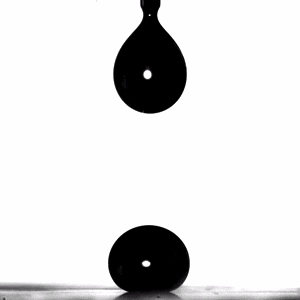
Experimental outcomes and numerical simulations.
The team observed six outcomes for impact dynamics. During impact, both drops deformed and spread radially to show axial compression, while the kinetic energy of the system transferred to the surface energies of both. When the drops began to retreat, the previously sessile drop transferred energy back to the impacting drop in the form of kinetic energy. After collision, the impacting drop bounced away, while the sessile drop stayed on the substrate. The scientists maintained a constant Weber number (We ~ 1.5) for all six observed cases; where the parameter typically characterized the atomizing quality of a spray or the resulting droplet size of emulsions. They then plotted the head-on alignment (denoted X) and increased the Weber number for coalescence of drops in the experimental setup. They credited the outcome to the instability of the air layer between the drops as a result of direct contact under the experimental conditions.
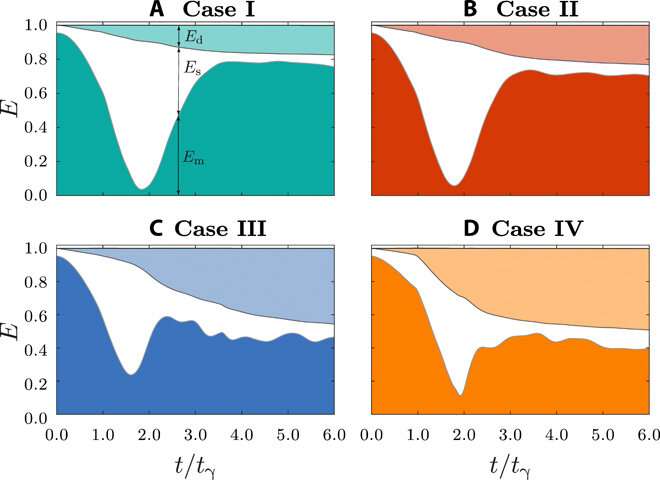
Ramírez-Soto et al. then conducted direct numerical simulations (DNS) to illustrate the effect of the velocity fields and energy transfer between drops and compared the results with the experimental data. The team used the geometric volume of fluid (VOF) method and preserved a finite layer of air between the drops throughout the process to mimic experimental conditions to achieve noncoalescing droplets using simulations. The team ran the first four simulations and quantified the velocity vector fields for each case; the results will make it possible to quantitatively explore dynamics of the oil drop-on-drop collision process.
Energy budget
In all cases, the impacting drop contained energy as mechanical energy (in the form of kinetic and potential energy) and as surface energy of the sessile drop. The mechanical energy of the system then decreased and transferred into the surface energy of the combined droplets. A recovery step followed the transfer, in which surface energy transferred back into the mechanical energy of the system, while a part of the energy dissipated in the form of viscous dissipation. This process accounted for combined energy dissipated in the liquid drops and in to the surrounding air. The calculations also accounted the layer of air between drop-on-drop contact as well as between drop-on-superamphiphobic substrate. The numerical simulations provided a quantitative description of impact dynamics, where a strong agreement existed between the drop boundaries and experimental mechanical energies.
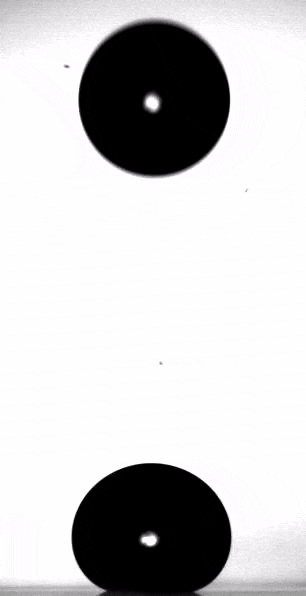
In this way, Olinka Ramírez-Soto and colleagues combined systematic experiments and numerical simulations to predict and control the outcome of binary oil drop impacts on low-adhesion surfaces. The experimental and numeric one-on-one comparisons revealed the drop boundaries and center of mass mechanical energies, while illustrating the power of direct numerical simulations. The study highlighted how the alignment of droplet impact alone could be used to determine the recovered energy distribution between two drops after impact.
More information: Olinka Ramírez-Soto et al. Lifting a sessile oil drop from a superamphiphobic surface with an impacting one, Science Advances (2020). DOI: 10.1126/sciadv.aba4330
Jolet de Ruiter et al. Wettability-independent bouncing on flat surfaces mediated by thin air films, Nature Physics (2014). DOI: 10.1038/nphys3145
Ryan Enright et al. How Coalescing Droplets Jump, ACS Nano (2014). DOI: 10.1021/nn503643m
Journal information: Science Advances , Nature Physics , ACS Nano
© 2020 Science X Network




















